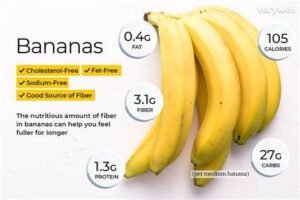Why Knowing the Best Alternatives to Safely Cool Food Matters
Have you ever heard someone say, “It’s fine to leave hot food out until it reaches room temperature before refrigerating”? If so, it’s time to bust this common myth! Cooling food properly isn’t just a minor kitchen hack—it’s a crucial part of food safety that can prevent foodborne illnesses. Today, we’ll explore some essential tips and tools that will not only keep your food safe but also preserve its flavor and texture. So, let’s get started and learn the best alternatives to cool your food safely, ensuring you and your loved ones stay healthy.
click to see an other blog
Understanding the Basics of Food Safety
When it comes to food safety, cooling food correctly is as vital as cooking it properly. Many of us are aware that cooking food to the right temperature kills harmful bacteria, but not everyone knows that how you cool food is equally important. Bacteria can multiply rapidly at temperatures between 40°F and 140°F, a danger zone where food should not stay for more than two hours.
Why Proper Cooling is Essential
Proper cooling techniques prevent your meals from lingering in this bacterial danger zone. Quick cooling of hot foods stops the growth of pathogens and ensures that leftovers are safe to eat. It’s not just about safety, though; proper cooling also preserves the quality of your food. Nobody enjoys a soggy lasagna or a dried-out roast that spent too much time exposed to air!
Food Safety Cooling Temperatures
To keep things safe, remember these numbers: perishable foods must be cooled from 140°F to 70°F within two hours and then from 70°F to 40°F within the next four hours. This two-step cooling process ensures rapid and safe reduction in food temperature, thwarting the efforts of bacteria to spoil your meal.
Incorporating these basics into your kitchen routine isn’t just following rules—it’s about caring for the health of everyone who eats your food. Whether you’re a home cook or a professional chef, these practices are fundamental. So, let’s keep these guidelines in mind as we delve deeper into specific cooling techniques that can be applied effectively in any kitchen.
The Best Safe Food Cooling Techniques
Cooling your food safely isn’t just throwing it in the fridge and hoping for the best. There are specific techniques designed to ensure your food passes through the danger zone quickly and safely. Here are a few methods that you can easily incorporate into your kitchen routine.
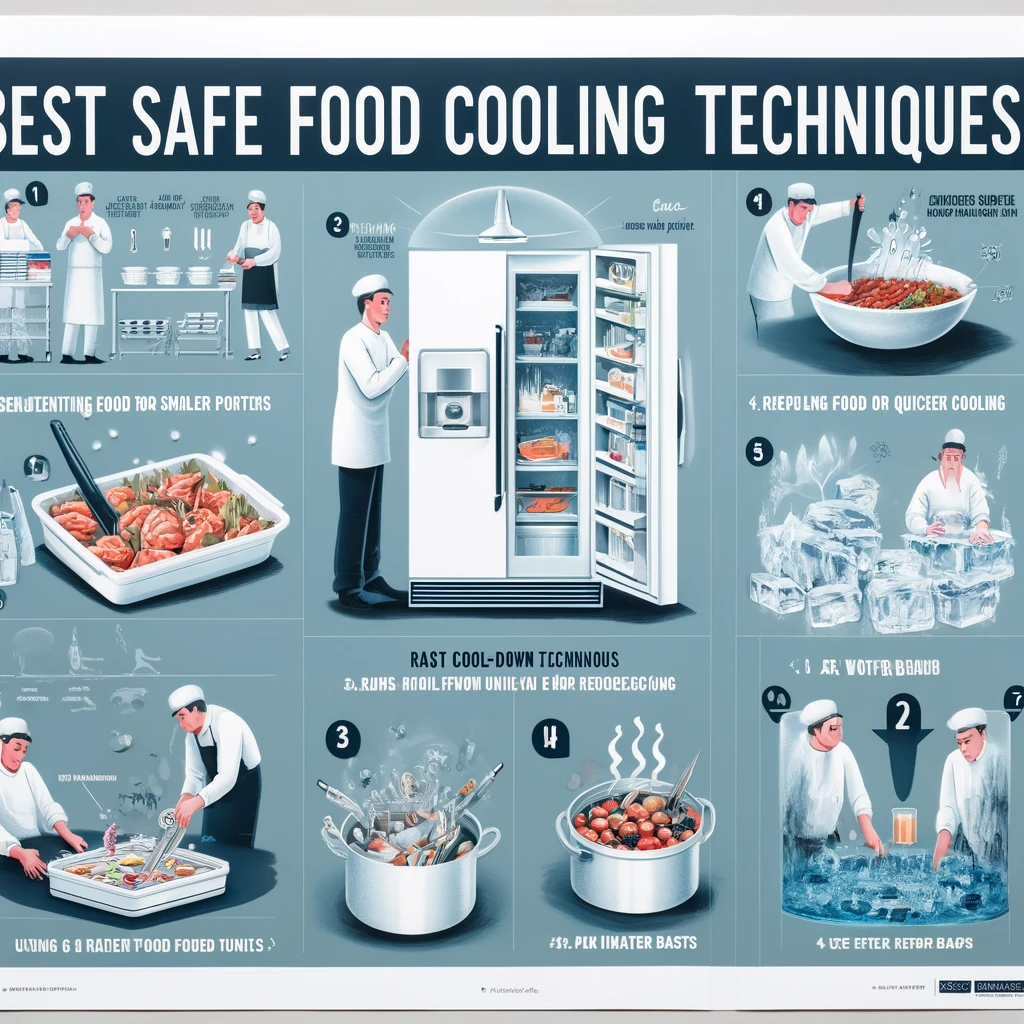
Rapid Cooling Techniques
Ice Water Bath: For liquids like soups and stews, one of the quickest ways to cool them down is using an ice water bath. Simply place your pot within a larger basin filled with ice water and stir continuously. This method can dramatically reduce cooling time and is especially handy when you’re meal prepping or cooking in large batches.
Divide and Conquer: Large volumes of food cool slower. So, if you’ve just cooked a big pot of chili, transfer it into smaller containers. Smaller portions allow heat to escape more quickly, reducing overall cooling time.
Use Shallow Dishes: Whether it’s a casserole or cooked rice, spreading your food in a shallow dish exposes more surface area to cooler air, speeding up the cooling process.
Avoiding Common Pitfalls
It’s vital to avoid leaving food covered during the initial cooling phase, as it traps heat. Also, never put hot food directly into your refrigerator as it can raise the internal temperature, putting other stored food at risk.
Click to see an other blog
Tools and Gadgets to Help You Cool Food Safely-The best alternatives to cool food safely
Equipping your kitchen with the right tools can make the cooling process not only quicker but also safer. Let’s look at some gadgets that are game changers in how we cool down our meals.
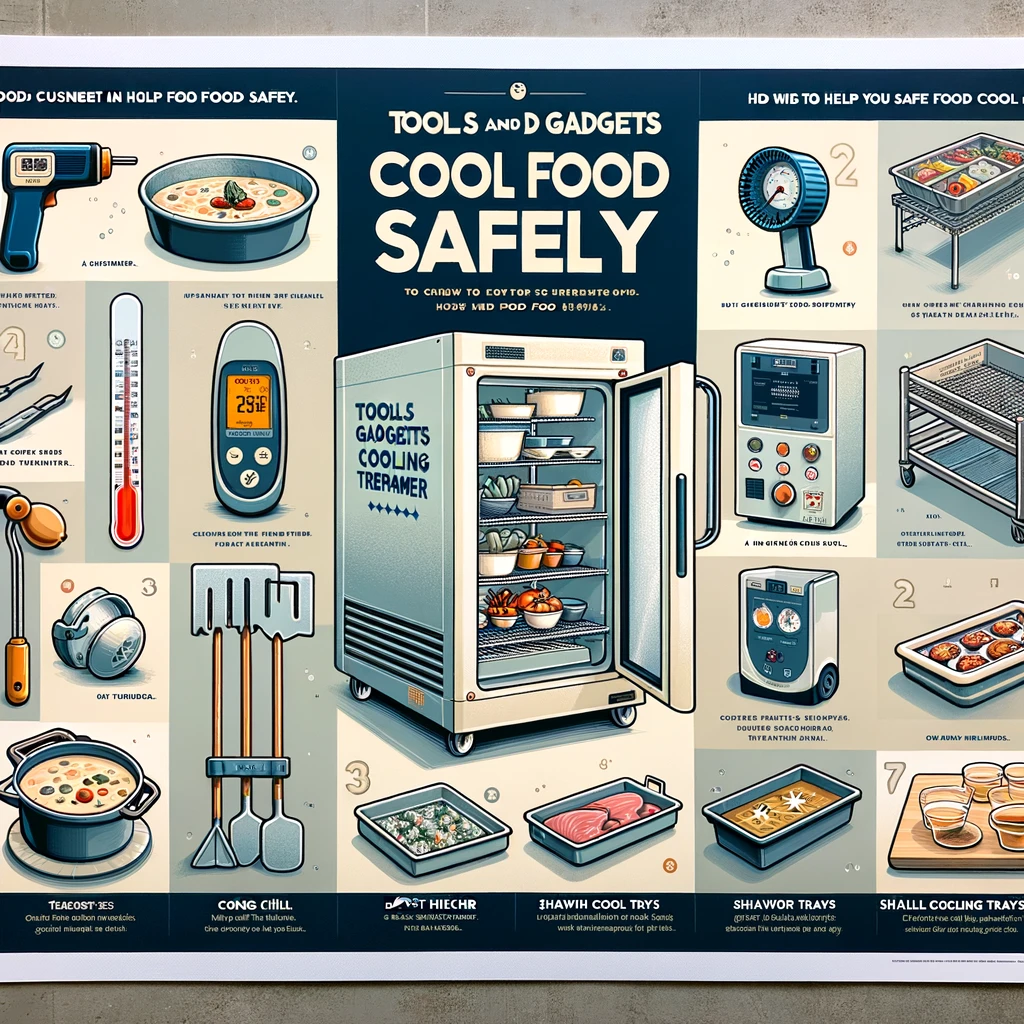
Kitchen Gadgets for Cooling Food
Cooling Racks: Originally designed for baking, cooling racks aren’t just for cookies or cakes. Placing hot pots or pans on a cooling rack improves air circulation around the container, helping to disperse heat more evenly and quickly.
Rapid Chill Pads: These are relatively new in the kitchen scene. Rapid chill pads can be placed under pots or containers to draw heat away from the food, significantly speeding up the cooling process.
Thermal Ice Packs: Typically used for injuries or packing coolers, thermal ice packs can be adapted for kitchen use. Place them around your food containers in a pinch to help chill food more rapidly.
Best Practices
Using these tools requires a bit of know-how. Always ensure that your gadgets are clean and used in a way that doesn’t contaminate your food. For instance, never let raw and cooked foods share the same cooling rack or ice bath without thorough cleaning in between.
Step-by-Step Guide to Cooling Specific Foods
Cooling food correctly is essential to maintain both safety and quality. Here’s how to manage a few common types:
Cooling Cooked Meats
When it comes to meats, rapid cooling is crucial. Slice large roasts or whole poultry into smaller pieces to expedite the cooling process. Place the slices on a cooling rack in a single layer, allowing air to circulate around each piece. This can significantly shorten the cooling time and reduce the risk of bacterial growth.
Handling Soups and Stews
For soups and stews, the ice water bath method works wonders. Immediately after cooking, place the pot into a sink or larger container filled with ice water. Stirring the soup or stew continuously helps distribute the heat and cool the contents faster.
Baked Goods and Casseroles
Baked goods and casseroles should be removed from their hot pans and placed on cooling racks or transferred to shallow dishes. This exposes more surface area to the air, helping them cool quicker. Be cautious with dense items like lasagnas or thick casseroles—they may need to be portioned into smaller pieces for effective cooling.
Cooling Rice and Grains
Spread cooked rice or grains on a shallow tray or baking sheet. The thin layer ensures that the heat escapes quickly and evenly. Once cooled, these can be transferred to a container and refrigerated.
Cooling Food in Professional Settings
In professional kitchens, cooling isn’t just a routine; it’s a critical control point in kitchen operations. Let’s explore some methods commonly used in these environments:
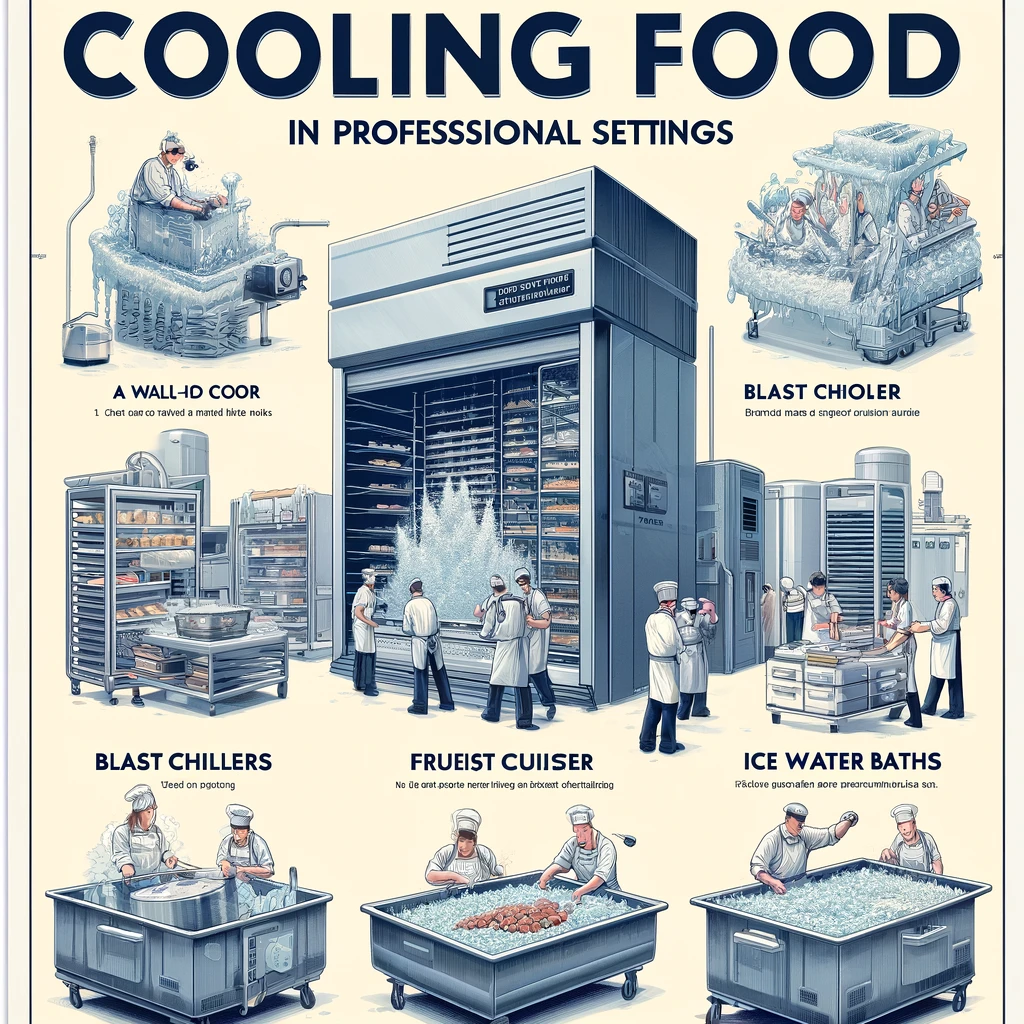
Using Blast Chillers
Blast chillers are the gold standard in professional kitchens for cooling food quickly and safely. These powerful devices can cool foods rapidly through forced air chilling, bringing down the temperature of hot foods within minutes.
Pre-Chilled Prep Tables
Many restaurants use pre-chilled prep tables. These tables have refrigerated compartments underneath where chefs can store ingredients at safe temperatures before and after preparation.
Scheduled Cooling Checks
Professional settings often implement strict schedules to check the temperature of cooling foods. This practice ensures that all food items are moving through the temperature danger zone quickly and safely. Keeping detailed records of these checks is also a compliance requirement under many health codes.
Continuous Training
Ongoing training on proper cooling techniques is a staple in professional kitchens. Regular staff training ensures everyone is up-to-date on the latest food safety regulations and techniques.
Frequently Made Mistakes in Cooling Food
Cooling food safely isn’t just about getting it into the refrigerator. Here are some of the most common errors people make, which can lead to food safety hazards:
Covering Food Too Soon
Many believe that covering food helps it cool quicker, but covering hot food can trap heat and create a steamy environment that’s perfect for bacteria to thrive. Always allow food to cool uncovered until it’s out of the danger zone, then cover it to store.
Placing Hot Food Directly in the Fridge
It might seem like putting hot food directly into the fridge is a good move, but this can raise the fridge’s internal temperature, putting other stored food at risk. Instead, use proper cooling techniques before refrigerating.
Not Using Ice Water Baths for Liquids
One oversight in many kitchens is not utilizing an ice water bath for cooling liquids like soups and stews. This method can drastically reduce cooling time and is highly effective in preventing bacterial growth.
Ignoring Portion Sizes
Trying to cool a big pot of food can be a food safety nightmare. Large quantities take longer to cool, often staying in the danger zone for too long. Dividing food into smaller, shallow containers can speed up the cooling process significantly.
Innovative Cooling Techniques in Culinary
With advancements in technology and a deeper understanding of food science, culinary professionals have developed innovative cooling techniques that not only ensure safety but also enhance food quality.
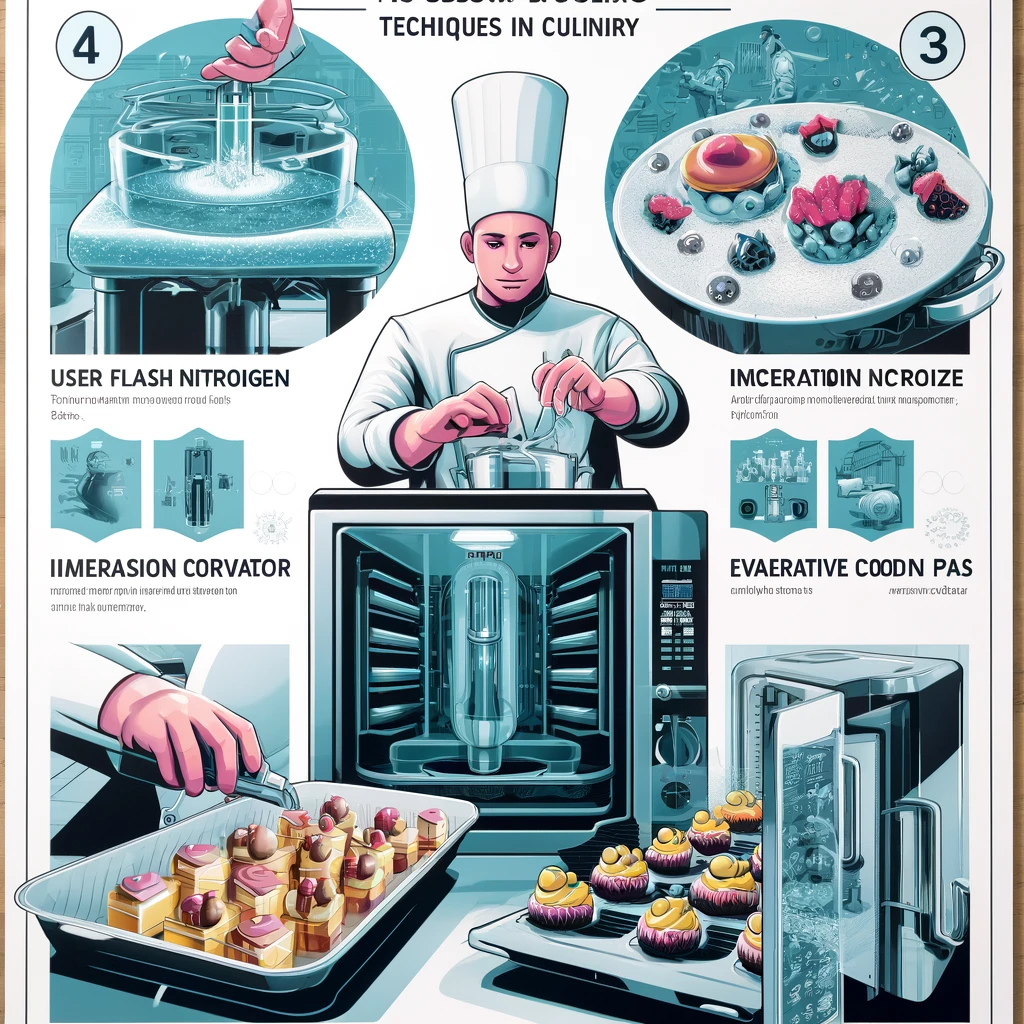
Sous Vide Ice Bath Method
An adaptation of the traditional ice bath, this method involves sealing food in airtight bags before immersing them in ice water. This technique is especially useful for sous vide cooking where precision in temperature control is crucial.
Blast Chilling
Moving beyond traditional refrigeration, blast chillers use high-velocity cold air to cool food rapidly. This method is ideal for kitchens that need to cool large amounts of food quickly while maintaining quality.
Liquid Nitrogen Flash Freezing
For those in high-end culinary fields or food production, liquid nitrogen offers a dramatic, rapid cooling solution. It’s particularly popular for quickly freezing delicate items without forming large ice crystals, preserving texture and flavor.
Thermoelectric Cooling
This newer technology uses electricity to create a temperature difference, cooling food quickly without the moving parts or chemicals associated with traditional refrigeration. It’s gaining popularity in small-scale and portable applications.
Wrapping Up: The best alternatives to cool food safely
Throughout this exploration of food cooling techniques, we’ve uncovered the crucial steps and innovative methods that ensure safety while maintaining the quality of food. From the basic principles of reducing temperatures swiftly to avoid the danger zone, to employing advanced tools like blast chillers and liquid nitrogen, each technique serves a vital role in kitchen safety and efficiency.
Pros
Understanding and applying these methods correctly can dramatically reduce the risk of foodborne illnesses. The rapid cooling techniques, such as the use of ice water baths and dividing food into smaller portions, are not only essential for safety but also help in preserving the freshness and texture of the food. The tools and gadgets we discussed, including cooling racks and rapid chill pads, are designed to enhance these processes, making them accessible to both professional chefs and home cooks.
Cons
However, while these techniques and tools offer significant benefits, they come with their own sets of challenges. For instance, the initial cost and space required for a blast chiller may not be feasible for smaller kitchens. Similarly, the use of liquid nitrogen, while effective for rapid freezing, requires careful handling and is not suitable for all types of food.
Final Verdict-The best alternatives to cool food safely
The journey to mastering food cooling is filled with both opportunities and obstacles. For culinary professionals, investing in advanced cooling technologies could greatly enhance food safety and quality, presenting a worthwhile return on investment. Home cooks can adopt simpler methods like ice water baths and proper food segmentation to achieve similar results without the hefty price tag.
In conclusion, whether you choose to incorporate high-tech gadgets or stick to traditional methods, the key is consistency and careful practice. By understanding the science behind food safety and applying these cooling methods diligently, you can ensure that your culinary creations are not only delicious but also safe for consumption. This balance of innovation, practicality, and safety is what makes modern culinary practices exciting and essential for anyone who takes food seriously.
FAQs – The best alternatives to cool food safely
Q: Can I just put hot food directly into the fridge to save time?
A: It’s tempting to save time by putting hot food directly into the fridge, but this isn’t recommended. Doing so can raise the temperature inside your refrigerator, risking the safety of other stored food. It’s better to let the food cool down a bit using safe methods like spreading it into shallow containers or using an ice water bath before refrigerating.
Q: How do I use an ice water bath to cool food?
A: An ice water bath is super effective for cooling down liquids like soups and stews. Fill a sink or large container with ice and water, then place your hot pot in the bath. Stir the contents regularly to help disperse the heat more quickly. This method pulls the temperature down fast and keeps your food out of the danger zone.
Q: What’s the best way to cool down meats quickly?
A: For meats, the best practice is to cut them into smaller pieces or slices to expose more surface area to the air. You can place these slices on a cooling rack in a single layer to ensure even air circulation, which speeds up the cooling process significantly.
Q: Are there any special gadgets I can use to help cool food faster?
A: Yes, there are several gadgets designed to help with cooling. Cooling racks are great for baked goods and meats, while rapid chill pads can be used under pots or containers to draw heat away more quickly. Thermal ice packs can also be adapted for kitchen use, placed around food to help it chill faster.
Q: What should I do if I have a large batch of food to cool?
A: Cooling large batches can be tricky, but you can manage it by dividing the food into smaller, shallower containers. This increases the surface area exposed to cooler air, speeding up the cooling process. Always ensure that these containers are spread out in the refrigerator to allow air to circulate freely.
Q: Is it safe to use liquid nitrogen for cooling in regular kitchen settings?
A: Liquid nitrogen is more commonly used in professional kitchens or for culinary applications that require rapid freezing, such as in high-end restaurants. It’s not typically recommended for regular home use due to the need for specialized equipment and safety precautions.




